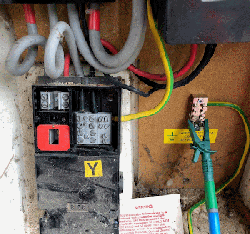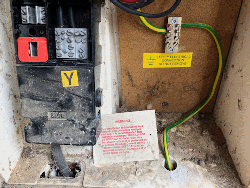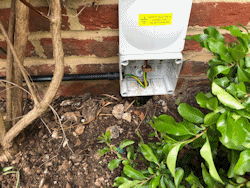

This section is given for information only, and your safety is your own responsibility. These notes cannot protect you for doing stupid things even if accidental.
This web site is made available on the understanding that any information is given in good faith and the BRATS cannot be held responsible for any misuse or misunderstanding. Particularly in this section where any doubt exists a suitably qualified electrical contractor must be consulted.
For more information refer to this pdf file:
8A1 Recall that lethal voltage can exist in equipment and that live circuits may be exposed as soon as the equipment case is removed.
The syllabus text says it all !!! Lethal voltages can exist in equipment, and that live circuits may be exposed as soon as the equipment case is removed.
There is a saying "It is the volts that jolt but the mills (Milliamps) that kill". It is considered that any voltage above say 40 volts can under circumstances be considered lethal when more than 10 mills of current flow.
Of course if you are opening up a valve RF amplifer, for instance, you may have 1000's of volts on the valve that is a very lethal voltage at such low milliamps current.
If you have to replace filters or components inside a transceiver then it MUST be turned off, and disconnected from mains supply. If not, you may not only cause you damage but quite possibly the same will happen to the electronic components of the device you are working on.
If you have to work on a live system then only use 1 hand out and the other in your pocket, so as to avoid a direct line to your heart in the worst case scenario. Also do not wear headphones while working on equipment as a sudden noise may cause you to grab the radio and complete a lethal circuit.
There are usually protection devices in equipment which turn off the mains supply when the case is opened but not always so err on the safe side and when opening a case unless the mains power is not only turned off but the mains plug removed that you are entering a very serious situation where death could be the result if you receive an electric shock.
8A2 Recall that in PME systems the main earth terminal is connected to the neutral of the electricity service at the consumers' premises
With the PME, which is better called a TNC-S Service (which is the correct name and may be the exams should use this) the neutral and earth are the same and separated at the main incoming fuse terminal.
TNC-S stands for Terra Neutral Combined Separate, in principle this means the supply to your house comes on a cable that has a combined neutral and earth function, known in the trade as a PEN cable, "Phase, Earthed Neutral". PME is a form of TNC-S where the combined neutral/earth is earthed multiple times between the substation and you, PME means Protective Multiple Earth.
However PME is not the only form of TNC-S, TNC-S can also be supplied as PNB, Protective Neutral Bonding. This is either a single point connection from a Pole mounted transformer, often rural overhead, or a new supply taken from a existing TNS service, where they join the neutral/earth together. PNB services only have 1 point of earthing, either at the joint or at the consumer service fuse.
So in essence the mains earth of your house is bonded or joined as it enters your house to the neutral conductor, which under normal operations for your house all will be fine BUT using faulty Amateur Radio equipment can cause some additional problems ...see below



The first photo above is PME with the new Earth wire connected to the new earthing block. Note the large white notice this indicates the original installation is PME.
The second photo above shows the new connection to the earth block of the earth cable from the internal consumer unit and note the new yellow notice below the earth block which now makes the installation TT.
The TT system is where the customer’s installations are connected to earth via a separate electrode ( earthing rod ) which is independent of the supply.
The third photo above shows the new earth connection to an earth rod and the lead to the meter box in conduit.
This was all carried out under a "Minor Electrical Installation Works Certificate" by a qualified electrician.
8A2 continued: Recall that under severe fault conditions PME systems have the potential to cause fatal electric shocks and/or fires in amateur radio stations.
When using Amateur Radio equipment with a fault, an Open Neutral on a TNC-S system can rise to about 50V, Also any RF earthing that has a direct or indirect connection to Neutral via the Link in the main fuse (understand that in the main fuse Earth and neutral are same point) can now carry the Full diverted neutral current for either your house or several houses depending where the break is located, this situation can lead to an RF earth fail and this will cause high potential in the wiring. This situation COULD cause a fatal electric shock to you via your radio equipment and maybe lead to a fire.
8A2 continued: Recall that the RF earth in an amateur Station should be connected to the PME bonding point in accordance with the District Network Operator's requirements or the IET Wiring Regulations to maintain safety under fault conditions.
If you cannot use a TT system which separates your shack supply from the TNC-S earth point, then a RF earth must be bonded back to the MET ( main earth terminal ), with a suitable sized cable, capable of taking diverted Neutral current. You can see suitable diagrams in the RSGB EMC07 booklet on pages 4 and 5.
In all electrical mains work if you are not qualified then you must use in somebody who is electrically qualified !!!!
8A6 Understand that no work should be undertaken on live equipment unless it is not practicable to do otherwise.
As soon as the covers are taken off a piece of electrical equipment connected to the mains supply there is a danger of electric shock. The source of a potential shock may not be easily apparent as the live terminals may be shrouded but what if a transformer's terminals are not covered ?
You might need to work on a piece of equipment to fault find whilst the mains power is connected but in that case you must know what you are doing and think about your safety before touching anything inside the case. nd again if you have to work on a live system then only use 1 hand and keep the other in your pocket, so as to avoid a direct line to your heart in the worst case scenario, also do not wear headphones while working on equipment as a sudden generated noise may cause you to grab the radio with your other hand and complete a lethal circuit.
8A6 continued: Understand that suitable precautions must be taken to avoid electric shock.
Suitable precautions that can be taken to avoid electric shock if you have to work on "live" mains equipment are :-
A final warning, Please do not wear rings and jewellery as if they catch an electrical component at high voltage could cause a burn, and on a low voltage supply the current they could carry would cause a severe burn.
The origin of some of the text on this page is from the RSGB with additions by the web master